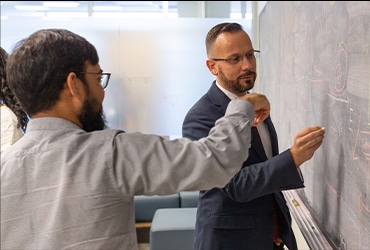Cancer as Hurricane: Heiko Enderling’s Models
As a resident of Florida, Heiko Enderling, PhD, often sees hurricane simulations and predictions on television, complete with cones of uncertainty. As a leading practitioner of mathematical biology, Enderling is reminded of the cancer models he develops as an associate member in the Department of Integrated Mathematical Oncology at Moffitt Cancer Center in Tampa.
“We are predicting the trajectory of the storm in an individual patient,” he says. “As we collect more and more data on an individual patient, our cone of uncertainty is getting narrower and narrower, and we have much more confidence in our predictions,” he says.
The methods used by Enderling and his team are conceptually similar to the work of meteorologists.

“During hurricane season, you take a satellite image,” he notes. “Then you run different mathematical models that are calibrated with the data from previous storms using the satellite images of the current storm.”
“And this methodology is exactly what we’re doing here, only that our satellite image of the storm is maybe a CT scan or an MRI scan of a tumor,” he explains. “The mathematical models are a bit different than the models we would use for weather forecasting, but the approach is very similar.”
Enderling calls his work “quantitative personalized oncology” and defines the mission of his group as integrating the approaches of the quantitative sciences into clinical decision making.
“Our vision is optimal cancer therapy for each individual patient,” he says. “By having these kinds of models that simulate different dynamics, you can have an expectation of how treatment is likely to respond. Then you can observe, how do the patients actually respond? And now you have a benchmark against which to compare the delivered clinical therapy and use this as a trigger for adaptation.”
At first Enderling wanted to be a computer programmer. He earned a master’s degree in computational visualistics from the University of Magdeburg in Germany in a program that combined computer science and medicine. Very interested in the life sciences part, he earned a PhD in mathematical biology from the University of Dundee in Scotland in 2006.
As a postdoc at the Center of Cancer Systems Biology at St. Elizabeth’s Medical Center in Boston, Enderling decided to build a mathematical model that could explain some of the dynamics of cancer stem cells.
“I put in everything I knew about cancer stem cells and simulated that forward in time,” he says. Unfortunately, he adds, “nothing that we expected actually happened.”
“It was a very simple model,” he says. “We only had three parameters—proliferation, apoptosis, and migration—and you would think that can’t be that difficult to understand. But everything, every question we asked, gave us a result we didn’t expect.”
Convinced the model was trying to tell him something, Enderling applied for, and received, the AACR Centennial Postdoctoral Fellowship Award in 2008. The award allowed him to conduct research that showed the model was right, and the expectations were wrong.
“The three basic components of tumor growth —cell proliferation, migration, and death —combine in unexpected ways to control tumor progression and, thus, clinical cancer risk,” as he and co-authors wrote in a paper crediting the award that was published in the AACR’s Cancer Research in 2009.
Key to his analysis was the concept of competitive release, a phenomenon in ecology that explains the seeming paradox that if cell death increases, the tumor grows faster. This is driven, he says, by cytotoxic treatment that kills sensitive cells but leaves others exposed to more resources that help them grow rapidly.
The research yielded several other papers and helped Enderling compete for a position at Moffitt. Once there, he took a keen interest in the clinical side of cancer medicine, in particular a clinical trial in prostate cancer. He found that the model he had used in his AACR grant was able to fit the new clinical data and also had predictive power about the course of the disease.
“So all of the work we’re doing now was developed with this very early junior postdoc support, so I’m ever so incredibly grateful for having had the opportunity to explore these systems back then,” he says.
Support from other funders has allowed his lab to continue its work in improving the models to assess individual patients.
“We now have NIH funding to build these kinds of mathematical models,” he says. “To make patient-specific predictions, we take early treatment response dynamics, we expose the patient to treatment, we measure how these patients respond, and based on early treatment response dynamics, we get remarkable accuracy in predicting how patients respond to subsequent treatment cycles.”
As leader of a research group whose interests span different disciplines, Enderling takes a keen interest in breaking down the silos that often seem to face young people thinking about careers in science.
“I spend a lot of time going to elementary schools, to middle schools and high schools, trying to tell students that have an interest in mathematics, that have an interest in physics or computer science, that there are careers in biology,” he says.” You don’t have to become an accountant or math professor. If you like math, you can actually help in solving the puzzle of cancer.”